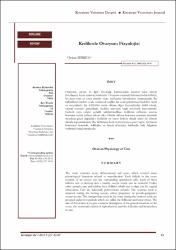Kedilerde Ovaryum Fizyolojisi
Özet
Ovaryum, üreme ile ilgili fizyolojik fonksiyonları kontrol eden birçok farklılaşmış hücre tipini içermektedir. Ovaryum üzerinde bulunan herbir follikül, bir adet oosit ve onun etrafını saran özelleşmiş hücrelerden oluşmaktadır. Bu folliküllerin herbiri ovule olabilecek sağlıklı bir oosit geliştirmeyi hedefler. Kedi ve tavşanlarda bir follikülün ovule olması diğer hayvanlardan farklı olarak, vajinal uyarımla gerçekleşir. Kediler mevsime bağlı poliöstrik hayvanlardır. Gebelik veya yalancı gebelik şekillenmedikçe, kedilerde çiftleşme sezonu boyunca östrüs siklusu tekrar eder. Östrüs siklusu boyunca ovaryum üzerinde meydana gelen değişimler folliküler ve luteal dönem olmak üzere iki dönem altında toplanmaktadır. Bu derlemede kedi ovaryumunun genel yapısı, üremenin hormonal kontrolü, folliküler ve luteal dönemler hakkında özlü bilgilerin verilmesi amaçlanmaktadır. The ovary contains many differentiated cell types which control many physiological functions related to reproduction. Each follicle in the ovary consists of an oocyte and the surrounding specialized cells. Each of these follicles aim to develop into a healthy oocyte which can be ovulated. Unlike other animals, cats and rabbits have follicles which can ovulate just by vaginal stimulation. Cats are seasonally polyoestrous animals. The oestrous cycle is repeated during the mating season, unless pregnancy or pseudo-pregnancy occurs in cats. The changes that occur in the ovary during the oestrous cycle are grouped under two periods which are called the follicular and luteal phase. The aim of this review is to give a concise description of the general structure of the ovary, the hormonal control of reproduction, and the follicular and luteal phase in cats.
Kaynak
Kocatepe Veteriner DergisiCilt
5Sayı
2Bağlantı
http://hdl.handle.net/11630/2317Koleksiyonlar
- Cilt 5 : Sayı 2 [7]



















